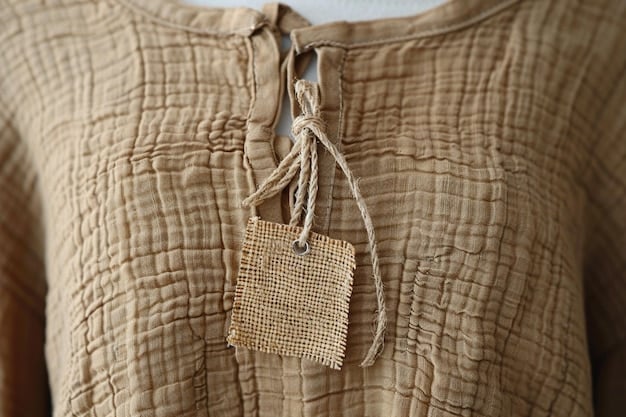Negotiate Like a Pro: Thrift Store & Consignment Shop Price Tips

Learning how to negotiate prices at thrift stores and consignment shops can significantly reduce your budget fashion finds expenses by employing insider tips such as identifying imperfections, understanding pricing policies, and building rapport with store staff.
Discover the art of savvy shopping and how to negotiate prices at thrift stores and consignment shops: insider tips for snagging amazing deals without breaking the bank, turning thrifting into an affordable fashion adventure.
Mastering the Art of Thrift Store Negotiation
Negotiating at thrift stores and consignment shops isn’t just about saving a few bucks; it’s about honing a skill that can benefit you in countless ways. Understanding the nuances of pricing, building rapport with staff, and knowing when to walk away are crucial elements.
Let’s dive into the tactics that can transform you from a casual browser into a negotiation ninja, ready to find exceptional value in pre-loved items.
Understanding Thrift Store Pricing Models
Different thrift stores have different approaches to pricing. Recognizing these models will help you anticipate potential negotiation points.
Some stores use a fixed-price system, while others are more flexible, especially with items that have been on the shelves for a while.
- Knowing the store’s discounting schedule (e.g., certain colors marked down on certain days) can be a goldmine.
- Consignment shops often have a tiered pricing structure with automatic markdowns over time.
- Don’t be shy about asking questions. A friendly inquiry can reveal valuable information.
Understanding these models allows you to plan your visits strategically and maximize your chances of scoring a deal.
Building Rapport with Store Staff
A friendly demeanor can go a long way in any negotiation scenario. Building rapport with the staff or manager at a thrift store can significantly increase your chances of a successful negotiation.
Treat employees with respect and show genuine interest in the store’s mission.
- Engage in polite conversation beyond the price of an item.
- Ask about the store’s history, their best finds, or upcoming sales.
- Acknowledge their expertise and ask for their opinion on items.
Remember, people are more willing to help someone they like and trust. A little kindness can unlock surprising opportunities.
By understanding the pricing models and building rapport with staff, you’re setting yourself up for more effective negotiations.
Spotting Opportunities for Negotiation
The key to successful thrift store negotiation lies in your ability to identify opportunities where prices might be flexible.
This could be due to the item’s condition, length of time on the shelf, or simply the store’s desire to move inventory.

Identifying Flaws and Imperfections
Carefully inspect items for any flaws, such as stains, tears, missing buttons, or damaged zippers. These imperfections can be your strongest bargaining chips because most thrift stores and consignment shops expect some wear and tear.
A small flaw can translate into a significant discount, especially if you’re willing to put in a little work to repair the item yourself.
- Be discreet when pointing out flaws. Avoid making a big deal out of minor issues.
- Frame your observation as a question, rather than a demand, like, “Is the price negotiable considering this slight imperfection?”
- Be realistic about the flaw’s impact on the item’s value. A minor stain might warrant a small discount, while a major tear justifies a more substantial reduction.
Remember to factor in the cost and effort required to repair the item when deciding how much to offer.
Leveraging Time on the Rack
Items that have lingered on the shelves for an extended period are prime candidates for negotiation. Ask politely if the store might be willing to offer a discount on older items.
Many thrift stores are eager to clear out slow-moving inventory to make room for new donations.
Check for items with older price tags or those relegated to clearance racks. These are clear signals that the store is ready to move them.
Spotting these opportunities and approaching them strategically can lead to significant savings.
Identifying opportunities, whether through flaws or time on the rack, is an essential skill for any thrift store negotiator.
Tactics for Nailing the Deal
Once you’ve identified potential negotiation points, it’s time to put your tactics into action.
Successful negotiation isn’t about being aggressive or demanding; it’s about finding a mutually acceptable price through respectful communication and creative problem-solving.
The Art of the Bundle
Purchasing multiple items at once can give you significant leverage. Bundle negotiation involves offering to buy several items if the store provides a discount.
This benefits the store by reducing inventory and increasing sales volume, while you get to walk away with a haul of thrifted treasures at a reduced price.

Find a few items you love and approach the cashier with a combined offer. For instance, ask, “If I take all of these items, could you offer me a 15% discount?”
- Strategically choose items with varying price points to create a more attractive bundle.
- Be prepared to adjust your offer slightly to reach a compromise.
- Consider offering to pay in cash for an additional discount.
The bundle tactic is a win-win situation for both parties involved, making it a powerful tool for thrifty shoppers.
The Walkaway Bluff
Sometimes, the most effective negotiation tactic is being willing to walk away. If the store is unwilling to meet your price, politely thank them for their time and start to leave.
This communicates that you are serious about your budget and aren’t afraid to miss out on the item if the price isn’t right.
More often than not, the store will reconsider and offer a counter-offer. However, be prepared to follow through with your walkaway if they don’t budge.
Remember, there are always more treasures to be found at another thrift store.
Mastering these tactics, from bundling to the walkaway bluff, will help you secure the best possible deals.
Knowing Your Limits and When to Walk Away
Even with the best negotiation skills, it’s crucial to know your limits and when to walk away from a deal. Don’t get caught up in the excitement of thrifting and overspend your budget.
Setting a maximum price beforehand and sticking to it will prevent buyer’s remorse and ensure you’re making smart financial decisions.
Defining Your Budget
Before you even enter a thrift store, establish a clear budget for your shopping trip. This will help you stay focused and avoid impulse purchases.
Consider how much you’re willing to spend on individual items as well as the total amount you’re comfortable spending overall.
- Use a budgeting app or spreadsheet to track your expenses in real-time.
- Prioritize your wants and needs to allocate your budget effectively.
- Factor in potential repair or alteration costs when setting your budget.
By defining your budget beforehand, you’ll be less likely to overspend and more likely to make informed purchasing decisions.
Recognizing Value vs. Price
It’s essential to distinguish between the perceived value of an item and its actual price which is a key skill in determining whether a negotiation is worthwhile.
Just because an item is cheap doesn’t mean it’s a good deal. Consider the item’s quality, condition, and how often you’ll actually use it.
Sometimes, it’s better to invest in a slightly more expensive item that will last longer and provide more value in the long run.
By recognizing the difference between value and price, you’ll make smarter purchasing decisions and avoid cluttering your closet with unnecessary items.
Knowing when to walk away is just as important as knowing how to negotiate. Always prioritize your budget and the item’s true value.
Ethical Thrifting and Negotiation
While negotiating prices is a smart way to save money, it’s important to do so ethically. Keep in mind that thrift stores and consignment shops often support charitable causes or local communities.
Lowballing excessively or being disrespectful to staff can undermine these efforts.
Supporting the Store’s Mission
Before you start negotiating, take the time to learn about the store’s mission and values. Many thrift stores donate a portion of their proceeds to charitable organizations or support community programs.
Being aware of this mission can influence your negotiation approach and encourage you to be more mindful of your offers.
Consider donating items you no longer need to the store, further supporting their cause. This creates a positive cycle of reuse and community support.
Remember, thrift stores are more than just places to find cheap clothes; they’re often vital community resources.
Fair Negotiation Tactics
Avoid using manipulative or dishonest tactics when negotiating. Be transparent about your reasons for requesting a discount and treat staff with respect.
Don’t exaggerate flaws or try to guilt-trip employees into lowering the price with kindness and clarity.
- Avoid offering unreasonably low prices that insult the value of the item.
- Be prepared to justify your offer with specific reasons.
- Always be polite and respectful, even if the store is unwilling to negotiate.
Ethical thrifting is about finding affordable treasures while supporting the store’s mission and treating others with kindness.
By supporting the store’s mission and practicing fair negotiation tactics, you can enjoy thrifting responsibly and ethically.
Maintaining Your Thrifted Wardrobe
Once you’ve successfully negotiated your way to a fantastic thrifted wardrobe, the journey isn’t over. Properly maintaining your finds is essential to ensure they last for years to come.
This includes cleaning, repairing, storing, and refreshing your pre-loved items.
Cleaning and Repairing Your Finds
Before wearing any thrifted item, thoroughly clean it to remove any lingering odors or potential allergens. Check and repair any damages or imperfections.
This might involve washing clothes, spot-cleaning stains, replacing buttons, mending tears, or fixing zippers, even doing all of these things. A little bit of effort goes a long way.
For delicate items, consider hand-washing or taking them to a professional cleaner.
Addressing any issues before wearing the item will prevent further damage and extend its lifespan.
Storage and Refreshing Tips
Proper storage is key to maintaining the quality of your thrifted wardrobe as well as regularly refreshing your items.
Hang delicate items or fold them neatly in drawers. Use cedar chips or lavender sachets to repel moths and keep your clothes smelling fresh.
- Rotate your wardrobe seasonally to prevent excessive wear and tear on your favorite items.
- Air out your clothes regularly to remove odors and prevent mildew.
- Consider using fabric freshening sprays or essential oil diffusers to keep your clothes smelling their best.
With some care and attention, your thrifted wardrobe can remain stylish and sustainable for years to come.
| Key Point | Brief Description |
|---|---|
| 💰 Pricing Models | Understand fixed-price, tiered, and discounting schedules for better negotiation. |
| 🤝 Building Rapport | Engage with staff, show interest, and treat them respectfully to improve your chances. |
| 🔍 Spotting Flaws | Identify stains or damages in clothes and leverage them for discounts. |
| 🚶♀️ Walkaway Bluff | Be ready to walk away if the price isn’t right; stores often reconsider! |
Frequently Asked Questions
▼
While not every item is up for negotiation, opportunities often arise with flawed or older items, especially if you’re buying multiple pieces. Building positive relationships with staff is key!
▼
Politely inquire about potential discounts, referencing visible imperfections or the item’s long shelf life. A friendly, respectful approach can go a long way in getting better deals.
▼
Factor in the item’s condition, the cost of potential repairs, and your budget. Research similar items online to understand their market value, too. Consider personal value relative to price so there is a clear understanding.
▼
Consignment shops might have different policies, yet negotiation can still be plausible, particularly for things that have been in the shop for a while. Just be personable and tactful!
▼
If meeting your price isn’t possible, politely thank them and consider whether exceeding your budget is worth it, remember there are other stores out there and more clothes can be thrifted.
Conclusion
Mastering the art of negotiation at thrift stores and consignment shops opens a world of affordable fashion possibilities. By understanding pricing strategies, building rapport, and knowing your limits, you can snag incredible deals while supporting sustainable shopping practices and extending your budget fashion finds. Happy thrifting!





